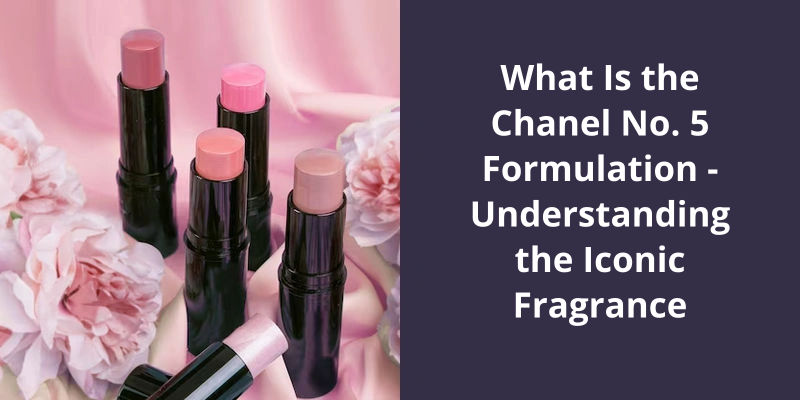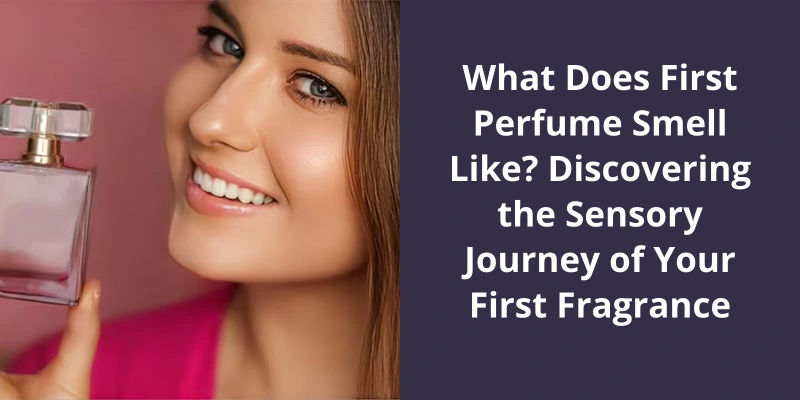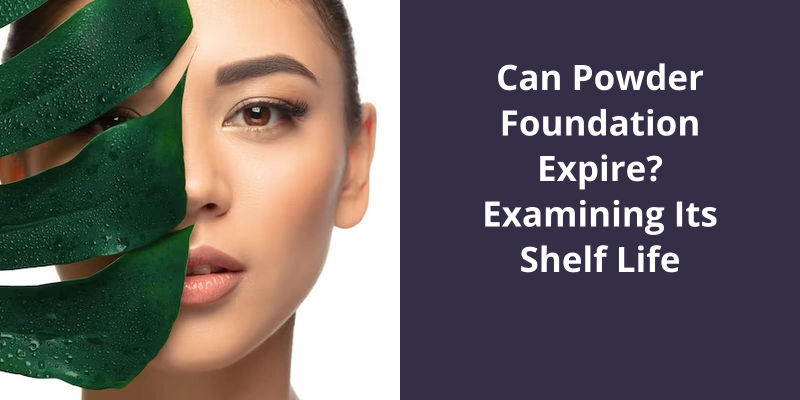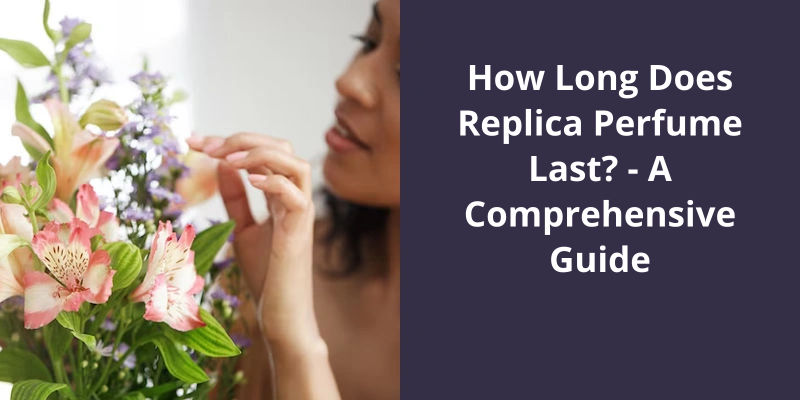The Chanel No. 5 formulation is a complex blend of many elements. It was created by French perfumer Ernest Beaux under the guidance of Gabrielle Chanel. This iconic fragrance features top notes of aldehydes, ylang-ylang, neroli, and bergamot. Its heart notes consist of jasmine, rose, lily of the valley, and iris while its base notes introduce a warm finish with elements of vetiver, sandalwood, vanilla, amber, and patchouli. The formula for Chanel No. 5 is considered a closely guarded secret, which has remained unchanged since its inception in 1921, making it an enduring symbol of luxury and a classic within the perfume industry.

Why Does Chanel No. 5 Smell Like Baby Powder?
Chanel No. 5 is a classic fragrance that’s remained an iconic scent for decades. It’s a distinct smell that’s been associated with sophistication and elegance. However, many people have noticed that the perfume has a striking resemblance to baby powder. This has led many to ask the question, why does Chanel No. 5 smell like baby powder?
She collaborated with perfumer Ernest Beaux to create a scent that was unlike any other at the time. Beaux used synthetic ingredients such as aldehydes to create a scent that was fresh, clean and modern.
The aldehyde accord in Chanel No. 5 is responsible for the clean and crisp smell that’s often associated with the fragrance. This accord is made up of a mixture of synthetic aldehydes and other aromatic compounds that give it it’s distinctive smell. These aldehydes have a powdery quality to them, which is why they’re often associated with baby powder.
In addition to the aldehyde accord, the rosy and jasmine notes in Chanel No. 5 are also reminiscent of baby powder. These notes give the fragrance a sweet and floral scent that’s often found in baby products such as lotion and powder. When combined with the aldehyde accord, these notes create a fragrance that’s both clean and sweet.
These compounds are derived from orris root and have a powdery, floral aroma that’s often used in baby products.
These ingredients, when combined, create a fragrance that’s both sophisticated and reminiscent of baby products.
While Chanel No. 5 has undoubtedly become an iconic fragrance over the decades, there’s been some speculation about whether the current formula is the same as the original. While the company asserts that it remains very close to the original, others argue that only a certain version of the fragrance truly captures the essence of the 1921 classic. Let’s take a closer look at the history and evolution of this beloved scent.
Is Chanel No. 5 the Original Formula?
Chanel No. 5 is an iconic fragrance that’s been captivating the senses of fragrance enthusiasts since it’s inception in the early 1920s. It was created by legendary perfumer Ernest Beaux and was launched by the iconic fashion house Chanel, which had already gained a reputation for it’s couture and fashion accessories. Chanel No. 5 became an instant hit among fashionistas and came to be synonymous with sophistication, glamour, and luxury.
The fragrance is said to have been inspired by Ernest Beauxs childhood memories of the snowy landscapes of his native Russia. It’s a blend of floral and woody notes, which are said to represent different facets of femininity. The top notes of the fragrance include bergamot, lemon, and neroli, which give it a fresh and citrusy vibe. The heart of the fragrance is composed of jasmine, rose, and ylang-ylang, which impart a sweet and floral aroma. The base notes of the fragrance are sandalwood, patchouli, and vanilla, which give it a warm and sensual finish.
Over the years, many people have questioned whether the current formula of Chanel No. 5 is the original one. According to the company, the formula for the fragrance has remained very close to the original, with some minor changes being made for legal and safety reasons. For instance, natural civet and certain nitro-musks, which were used in the original formula, are no longer used due to ethical and safety concerns.
Despite this, perfume experts and historians hold that it’s only the Extrait that closely mirrors the original 1921 version of Chanel No. The Extrait is a highly concentrated version of the fragrance, which contains a higher percentage of the fragrance oils than the other formulations. It’s said to be the most luxurious and long-lasting version of the fragrance, and is favored by many connoisseurs of perfumery.
It’s inspired countless imitations and influenced the course of the perfumery industry. It’s enduring appeal is a testament to the timeless elegance and sophistication that it represents, and it’s status as an icon of fashion and beauty is unlikely to fade anytime soon.
The History of Chanel as a Fashion House and How Chanel No. 5 Fits Into the Brand’s Legacy
Chanel is a prominent fashion house, founded by Coco Chanel in 1910. The brand revolutionized women’s clothing industry in the early 20th century. Chanel No. 5, a perfume launched in 1921, became an iconic fragrance and featured prominently in the brand’s legacy.
Perfume lovers around the world have long been enchanted by Chanel No. 5’s iconic scent. But a question that’s recently been on the minds of many is whether the fragrance has undergone any changes in it’s smell over the years. Chanel claims that the formula used to create No. 5 has remained largely the same, with just a few necessary tweaks. Curious to know more? Read on to discover all you need to know about the scent of Chanel No. 5.
Has the Smell of Chanel No. 5 Changed?
Many people wonder if the iconic scent of Chanel No. 5 has changed over the years. Chanel has gone on record stating that the formula used to create No. 5 hasn’t changed much since it’s creation. However, there are some ingredients that have been excluded from the perfume due to ethical and environmental concerns. Some of these ingredients include natural civet and certain nitro-musks.
According to perfume experts, the scent of No. 5 has remained virtually the same since it’s creation in 192The perfume is a carefully crafted blend of floral and musky scents that’s stood the test of time. Women all over the world continue to choose No. 5 as their signature fragrance.
However, the formula used to create the perfume remains unchanged, and millions of women continue to wear No. 5 as their go-to fragrance.
The History of Chanel No. 5, Including It’s Creation and the Iconic Chanel Brand
- Chanel No. 5 was created in 1921 by Gabrielle “Coco” Chanel.
- The iconic scent was the first fragrance released by the Chanel brand.
- Chanel No. 5 was given it’s name because it was the fifth fragrance that perfumer Ernest Beaux presented to Coco Chanel.
- The fragrance has a floral-aldehydic scent, with notes of ylang-ylang, jasmine, and rose.
- In the 1920s, Chanel No. 5 was popularized by it’s association with Marilyn Monroe, who famously said she wore nothing to bed except for a few drops of the fragrance.
- Today, Chanel No. 5 is still one of the most iconic fragrances in the world.
But the story of Chanel No. 5 doesn’t end with just the specific type of roses used. There’s much more to the iconic scent than just it’s floral ingredients.
What Is the Main Flower in Chanel No. 5?
Chanel No. 5 is considered an icon in the world of fragrances. It’s been around for almost a century and has gained a reputation as one of the most luxurious and elegant perfumes ever created. The main flower in Chanel No. 5 is the Rosa centifolia, also known as the cabbage rose. Known for it’s rich and fragrant scent, the cabbage rose is an integral ingredient in the perfume and defines it’s unique aroma.
The Rosa centifolia has been used in fragrances for many centuries. The rose is believed to have originated in Persia and has been a symbol of beauty, love and romance throughout history. It’s a popular choice among perfumers because of it’s intense fragrance and complex aroma.
The perfume features a bouquet of flowers, including jasmine and ylang-ylang, but it’s the use of the Rosa centifolia that defines it’s fragrance. The rose adds a depth and complexity to the scent that’s unmatched by other floral notes.
The Rosa centifolia used in Chanel No. 5 is grown exclusively in Grasse, a small town in the south of France. Grasse is known for it’s long tradition of cultivating flowers for use in perfumes, and it’s home to some of the most fragrant and beautiful roses in the world. The roses are carefully cultivated and harvested by experienced perfumers who know how to extract the oils from the roses without damaging the scent.
Source: The Flowers that Make Chanel No. 5 The New Yorker
Over the years, Chanel No. 5 has become an enduring symbol of timeless elegance and luxury, sought after by women around the world. It’s legacy has been shaped not only by it’s iconic creator, but also by generations of loyal fans who continue to cherish it’s unmistakable scent and sophisticated allure.
When Did Chanel No. 5 Become Popular?
With it’s unique blend of floral and musky notes, Chanel No. 5 became an instant classic, captivating the senses of women worldwide. But it’s popularity was not solely due to it’s seductive scent. Coco Chanels clever marketing strategy made Chanel No. 5 not just a perfume, but a symbol of glamour and luxury.
Over the years, Chanel No. 5 remained popular, even during the turbulent times of World War II when luxury goods were scarce. Ironically, it was during this period that the perfume achieved it’s greatest propaganda coup. It’s said that when asked what she wore to bed, Marilyn Monroe replied, “Chanel No. 5.”. The quote became legendary and cemented the perfumes position as a symbol of Hollywood glamour.
Conclusion
In conclusion, the Chanel No. 5 perfume formulation is a masterpiece of olfactory artistry, carefully crafted to create a fragrance that’s more than the sum of it’s parts. The use of a complex blend of aldehydes and florals, layered over a warm woody base, creates a nuanced and sophisticated scent that defies simple description. This perfume is a testament to the power of the perfumer's craft, and has rightly earned it’s place in the pantheon of great fragrances.





